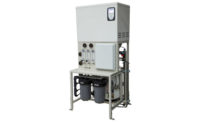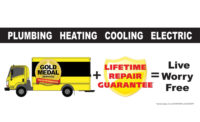Technology is redefining how consumers control their homes. That includes everything from lighting to mood music to heating and air conditioning. Most HVAC manufacturers have apps to help their customers remotely control their equipment, but now, consumers are using digital assistants, like Google Home, Apple HomePod, and Amazon Alexa, to dictate the temperatures in their homes.
According to Statistica, the market for artificial intelligence (AI) personal assistants and bots is projected to reach $12 billion by 2020. Additionally, the global smart home automation market is expected to reach $130 billion by 2025, according to a report by Grand View Research Inc. HVAC manufacturers are taking note of this growing trend and working to give consumers the products they want.
VOICE CONTROL
The popularity of digital assistants is increasing consumer awareness and the adoption of smart home products, according to Greg Polce, vice president of product planning for White-Rodgers, Emerson’s Commercial and Residential Solutions platform. Consumers have been slower to adopt smart home technology than industry experts have forecasted. Polce said this is due to a myriad of factors, including concerns about reliability, value, ease of use, and privacy.
“Smart speakers have become the gateway product to a smart home, and we believe this trend will continue to increase in popularity,” he said. “Amazon, Google, and now Apple all have strong smart speaker offerings, and this is becoming a requirement for consumers to adopt their respective smart home ecosystems. However, we do not believe that voice control should be embedded in every product within a room. Most current adopters of smart home products are making purchase decisions based on what works the best for them, with smart home platform compatibility as a key driver. So, our focus has been to partner with the industry leaders who are making these popular smart speakers, so products like our Sensi Wi-Fi thermostats can integrate with whatever devices work best for our customers’ lifestyles.”
In fact, Emerson plans to introduce its first Wi-Fi enabled ceiling fan, the 60-inch Sweep Eco Wi-Fi, which will connect to Amazon Alexa and allows consumers to control their home comfort from anywhere in the world. The fan can be operated via voice control or the Emerson app, allowing for convenient speed and light operation, scheduling, fan grouping, running in reverse, and simulating a natural breeze in Breeze Mode, among other functions.
Gene LaNois, head of professional channel, Google, said the biggest trend in the smart, connected home market is voice control and integration with other products.
“In the HVAC world, the thing that creates a lot of interest from contractors is providing a great combination of products that work seamlessly together for the unique needs of each customer,” he said. “For example, if you have a Nest thermostat and a Nest Protect, and the Protect senses CO, smoke, or a fire, it automatically tells the Nest thermostat to shut the system down because it could be the possible cause, or you don’t want it to feed the fire. At the same time, that might create a trigger to connected lighting, which blinks the lights red to create additional signals. So connecting products across the smart home is critical.
“We have lots of HVAC Nest Pro partners that are utilizing Nest thermostats to offer ‘voice controlled comfort,’ and they are including a Google Home or Google Home mini with the installation, or offering to connect it with an Amazon Alexa if they have one of those in the home already,” LaNois continued.
But as voice control becomes more mainstream, consumers have developed an expectation of being able to control any connected device by voice, which makes perfect sense.
“For us, we’re really open to having other devices work off the Google Assistant platform,” LaNois said. “This is all being driven by consumer demand, triggering super-fast adoption. We’ve seen studies, like the Coldwell Banker Smart Marketplace Survey, asking people the reasons why they purchased smart home products. If you’re an industry person, you’re expecting to hear answers such as, ‘I needed a new thermostat,’ or ‘I was trying to save more energy,’ or ‘I needed remote control.’ But the No. 1 reason you hear from these surveys is the ‘cool’ factor. It’s not the answer you were expecting as an industry solution provider.”
INTEGRATION
According to George Land, connected home solutions and general manager for Trane, builders and homeowners are seeking a seamless and intuitive experience, both when interacting directly with their system and when integrating it into the broader context of the various systems in the home.
“In home automation, we are seeing inexpensive, wireless home automation systems, like Nexia, gaining momentum compared to traditional wired systems that are very expensive, proprietary, and complicated,” he said. “And yes, voice control has seen an unprecedented adoption rate with consumers. We see our customers adjusting their systems and inquiring about the status through the two major dedicated voice portals [Google and Amazon] as well as voice control through our app. For us, it is all about consumer choice — the right interaction for the right consumer at the right time. It might be most convenient to say ‘Alexa, it is hot in here’ from the couch, but if your spouse is asleep next to you, it might be more appropriate to use an app.
Adrien Lafond, chief marketing officer, Airboxlab, said he’s noticed a slowdown in enthusiasm for smart home devices because consumers ask for more value now from their devices, and that’s where home automation comes in. The real value for homeowners is rarely realized by just one device alone, he said. The value materializes when a device works in conjunction with other devices.
“Take the example of Foobot and our other products: In and of itself, they tell you when your air quality at home is great, fair, or poor,” said Lafond. “That’s interesting because you didn’t know that information before. But for most of our users, that is just a first step. The next step is to get clean air, and an automation with the HVAC system is an easy way to get it. Smart devices for HVAC need to speak the same language to work seamlessly together, like BACnet, for instance.”
Blake Edwards, senior product marketing manager, controls, Lennox, said new innovations are driving the home automation trend in addition to the tech-savvy millennial generation who are now becoming homeowners.
“As they are buying homes, they’re looking for ways to incorporate that technology in levels of convenience and ease of use,” he added. “It’s very fast-paced. We’re seeing a continuous progression of innovation and technology that’s really translating to new products and these market needs that the consumers want. On the HVAC side of the business, we have to adapt and be proactive for future outlooks of what consumers are going to want and how they’re going to incorporate the devices they have in their homes.”
AJ Smith, vice president and general manager, Homes Pro Install Comfort, Honeywell Home and Building Technologies, said there have been many new entrants to the market over the past few years because it’s trendy to be in the smart home business.
“A lot of the connected devices within the home are becoming more mainstream,” he said. “What also tends to come along, similar to what we see in other industries, is any of the businesses, services, or devices that come onto the scene that are more novelty or playing to the trend versus playing to the underlying need start to fade away a little bit. It becomes less of the shiny object of things and more getting down to the core value of delivering energy efficiency, comfort, or protection and security of things.”
There is also a growing trend of having a lot of these devices be compatible, Smith added, saying that while some manufacturers are trying to integrate voice technologies into the products themselves, there is a distinctness in the value of having some sort of AI assistant in the home versus having that voice control embedded into each and every device.
“People don’t want to talk to every single camera or thermostat or other device in the home — they want all of these things to work together,” he said. “The compatibility aspect is there, but it’s not necessarily been the type of thing that is successful within each and every product itself. We’ve gone through this evolution early on. Instead, we’ve focused so much more on compatibility of our product, and then having everything within the home work together.”
This is partially because people are more connected and busier than ever, Smith noted. In order for people to stay engaged with their home and get the maximum amount of value of comfort or security, the device must be convenient and accessible. If people have chosen a voice-enabled AI assistant to be the thing they interface with in their home, they don’t want to go to something else to control the rest of the things in their home. They’d rather have a one-stop shop, he said.
LOOKING AHEAD
With consumer demand for smart, compatible, connected devices growing, the future looks bright for the home automation market.
“There is this study from Gartner predicting a huge acceleration for smart device sales by 2020,” Lafond said. “Specifically for the HVAC industry — if ASHRAE moves forward with a unified protocol used by all, like BACnet — then I think great business opportunities will arise for the ones who invested early enough in products and services related to home and building automation.”
Polce added that most homes will have already started on the connected home journey in five years, with digital assistant devices gaining penetration with the late majority.
“The early majority will have selected a smart home platform and have three or more smart home devices by then,” he said.
Technologies will continue to evolve, and with the home being such a personal and customized place, no single system will be dominant in the market. Instead, best-in-class providers will offer targeted solutions that work seamlessly with each other to provide an overall smart home solution, Land noted.
“In five years, home automation systems may be using artificial intelligence to anticipate your needs and suggest solutions, as well as analyze data in real time to determine more clearly what is happening in a home,” he said.
According to Edwards, technology and innovation will continue to drive new ideas and insights into the market, and contractors will become more comfortable with home automation and how they can fit it into their business offerings.
“In years past, having home automation capabilities in your home was a rarity, whereas now, it’s almost expected, and that’s going to continue more and more,” he said. “It will continue to grow as it has been, just at a much faster pace. It will become the new norm in the market.”
LaNois suggested voice control will continue to grow, along with the ability of other devices to listen.
“There will also be deeper integrations with third-party manufacturers,” he added. “Whether that’s a furnace with Google Assistant built in, those are totally plausible. It’s exciting, and it will take a little while to get there, but you’re already seeing what’s happening with Nest and Google. We can take good products and put the artificial intelligence into that product to enable it to communicate within the same app so that a person who wants to control their home is not having to jump around to different apps. There will be more artificial intelligence and learning algorithms, so the home will start to know what you want, when you want it.”
Publication date: 4/30/2018
Want more HVAC industry news and information? Join The NEWS on Facebook, Twitter, and LinkedIn today!











